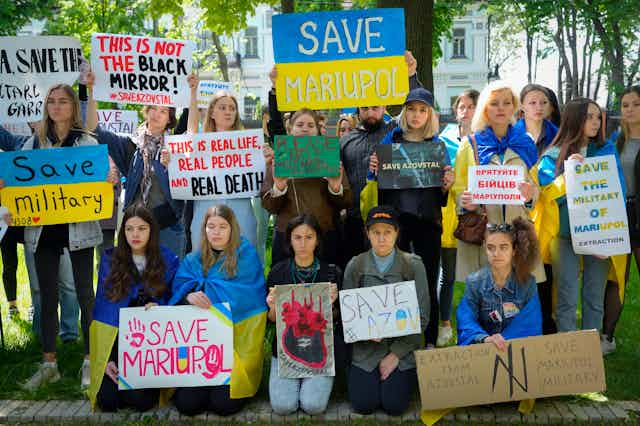Amid evidence of rape and other forms of sexual violence committed by Russian forces in Ukraine, the foreign affairs minister of the Netherlands, the Prosecutor of the International Criminal Court and the EU Commissioner for Justice recently hosted the Ukraine Accountability Conference.
At that conference, 45 countries — including Canada — adopted a statement strongly condemning the use of sexual violence as a method of warfare in Ukraine and underlining the need for specialized support and gender-responsive treatment for survivors.

Canada’s Justice Minister David Lametti also indicated that Canada is supporting a number of international and domestic justice efforts to address conflict-related sexual violence in Ukraine.
Conflict-related sexual violence has been reported in Ukraine since the 2014 takeover of Crimea and installation of Russian-controlled forces in Donbas.
The United Nations Office of the High Commissioner for Human Rights documented multiple examples of conflict-related sexual violence between 2014-21 against both women and men.
Tortured while detained
Most incidents occurred while the victims were detained or otherwise deprived of their freedom by armed groups and government forces. Perpetrators used beatings and electrocution of the genitals, rape, threats of rape and forced nudity to torture, punish, humiliate or extract confessions from the victims.
To further pressure the victims, the perpetrators threatened also to detain, abduct, rape, injure or kill the victims’ children and other relatives. Sexual violence against women was also documented outside of detention, including in residential areas close to military positions.
In addition, female victims reported being subjected to forced nudity, sexual touching and sexual assault in exchange for passage through checkpoints.
Given these and other similar reports from human rights organizations, it’s unsurprising that the Prosecutor of the International Criminal Court concluded in 2019 that there’s reasonable basis to believe that the war crimes of rape and other forms of sexual violence have been committed in eastern Ukraine.

Risk factors increase
The Russian invasion of Ukraine in February 2022 and subsequent occupation of Ukrainian towns and cities significantly magnified the risk factors for conflict-related sexual violence.
That’s because of the presence of armed forces in populated areas, large-scale internal displacement, destruction of homes and infrastructure, deprivation of liberty and restrictions on freedom of movement — including through the use of checkpoints — and the collapse of law and order.
All of these heighten vulnerability for women and children, in particular, in the midst of war.
In view of these risk factors, and the history of sexual violence in eastern Ukraine and Crimea since 2014, it is wholly unsurprising that reports of sexual violence began to emerge in 2022 from areas that had been occupied by Russian forces.
In April 2022, following the attacks by Russian forces in Bucha, Ukraine’s human rights ombudsperson documented cases of approximately 25 girls and young women aged 14 to 24 who were detained, raped and impregnated by occupying Russian soldiers in a basement.

The United Nations High Commissioner for Human Rights, the UN Secretary-General’s Special Representative for Sexual Violence in Armed Conflict, the Organization for Security and Co-operation in Europe and other groups have reported cases of conflict-related sexual violence, particularly rape and forced nudity, across the country.
These assaults often take place in conjunction with other crimes, including killings.
Rape, sexual slavery and other forms of sexual violence are crimes against humanity and war crimes under the Rome Statute of the International Criminal Court.
The International Criminal Court has successfully prosecuted various forms of rape and sexual slavery. Other international criminal tribunals have done the same, and also recognized acts such as forced nudity as violations.
Challenges
Even amid the evidence and suitable legal categories for various offences, there are many challenges to safely, ethically and effectively investigating conflict-related sexual violence for the purposes of holding individuals accountable. That’s regardless of whether the investigations are conducted through the International Criminal Court, Ukraine’s domestic justice system or the justice systems of other countries.
Among those challenges:
Russian-occupied areas and areas of live warfare are often not accessible to investigators.
Survivors may lack physical security, could be living in an atmosphere of impunity, may fear retaliation and stigma and may be suffering from physical and psychological trauma.
Survivors may be focused on providing for their and their families’ immediate needs.
Survivors may not have access to health care or other assistance.
This is why investigations of conflict-related sexual violence by the International Criminal Court, the government of Ukraine and others require a co-ordinated, survivor-centred and trauma-informed approach.
The international community has learned many lessons over the course of prosecuting sexual violence stemming from conflicts in the former Yugoslavia, the genocide in Rwanda, the civil war in Sierra Leone and elsewhere.
This has led to the development of best practices in how to document, investigate and prosecute conflict-related sexual violence.

For example, Nobel Prize recipient and sexual violence survivor Nadia Murad worked with a team to launch the Murad Code, a global code of conduct for those collecting information from survivors of conflict-related sexual violence.
The Prosecutor of the International Criminal Court has implemented a policy paper on investigating and prosecuting sexual and gender-based crimes, and the United Kingdom’s Preventing Sexual Violence in Conflict Initiative created the International Protocol on the Documentation and Investigation of Sexual Violence in Conflict. These best practices are being used in Ukraine today.
The good news is that investigators, law enforcement and civil society representatives working in Ukraine recognize the need for careful organization of their collective efforts to avoid, as much as possible, retraumatizing the survivors of conflict-related sexual violence.
This was one of the goals behind the recent Ukraine Accountability Conference: to ensure that survivors of conflict-related sexual violence in Ukraine see some measure of justice through co-ordinated, carefully planned action.

